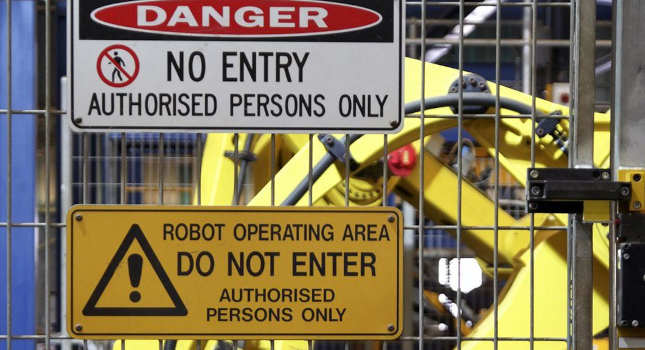Health and Safety Regulation: What to do if you are issued an OSHA citation
What a citation is and what it means
The Occupational Health & Safety Administration (OSHA) is the federal agency that oversees workplace safety. OSHA conducts thousands of such inspections every year on both the state and federal level. If a violation is discovered during the inspection, a citation may be issued. Citations serve as warnings, signaling the employer to take action to resolve the violation. After receiving a citation, the employer must post a copy of it at or near the place where each violation occurred for at least three days or be issued an OSHA posting requirement violation.
Enforcement of machine guarding regulations is part of OSHA’s mission. OSHA requires that “any machine part, function, or process that may cause injury” be equipped with appropriate risk reduction measures. Many of these machine parts, functions and processes need to be properly safeguarded at the point of operation, as well as at other areas where hazards are present.
Despite regulations outlined in OSHA 1910.212, and the serious dangers posed by industrial equipment, machine guarding violations remain one of the top ten most common OSHA citations. Machine guarding violations also hold the dubious distinction of making the list of OSHA’s largest monetary penalties.

CREATOR: gd-jpeg v1.0 (using IJG JPEG v80), default quality
What is an OSHA citation?
An OSHA citation contains allegations of a violation, not conclusive findings. And while an OSHA citation may certainly look like a final ruling, sometimes including an invoice and a notice of debt collection, the citation only becomes final after the employer:
- Agrees with the citation or some modification thereof through a settlement.
- Fails to contest the citation within fifteen working days.
- Contests the citation and loses in the administrative litigation process.
By law, OSHA must conduct an investigation before issuing a citation, most likely after an OSHA compliance safety and health officer conducts an on-site inspection. An investigation file should exist that has evidence that supports OSHA’s citation. Unless the employer contests the citation and proceeds to the administrative litigation process, however, they are not privy to what is in the file.
If an employer is not sure if they want to contest the citation, they can schedule an informal conference with an OSHA area director, a practice that OSHA encourages. An OSHA citation should never be ignored, and employers should act immediately upon receiving a citation. An extension of any amount of time beyond fifteen working days from the date an employer receives a citation generally isn’t granted unless the employer submits a Petition for Modification of Abatement, and the employer is able to provide tangible proof that they are working to achieve regulatory compliance. If the employer fails to remedy the citation by the abatement date, the citation becomes final, and they are liable for any penalty incurred. Yet simply paying a fine does not get the employer off the hook. The employer must still correct any violation for which they were cited. OSHA also has the right to shut down the worksite to protect employees.
Now, let’s explore the three most common types OSHA violations:
- Serious violations refer to situations where the employer should know that their employees are exposed to recognized hazards that would likely cause serious physical harm or death. The current penalty for a Serious violation could be as much as $ 14,502 per violation.
- Willful violations refer to situations where the employer knowingly and blatantly ignores recognized hazards that would likely cause serious physical harm or death with indifference or disregard to the law. The current penalty for a Willful violation could be as much as
$ 145,027 per violation. - Repeated violations refer to situations where the employer has been cited for a specific violation in the past, and a subsequent inspection reveals additional identical or similar violations to those for which they’ve already been cited. The current penalty for a Repeated violation could also be as much as $ 145,027 per violation.
Some factors that may weigh into size of the penalty issued per violation could be the nature of violation itself, the employer’s safety record, the size of the employer, and the good faith of the employer including the level of cooperation that they demonstrate.
Contesting a citation
If an employer agrees to the citation, they must pay the fine within fifteen days, along with correcting the violation by the abatement date indicated on the notice.
However, there are a number of reasons why an employer might choose to contest the citation. These can include arguing that the violation never occurred, that the abatement is too costly to implement, that workers’ compensation premiums will become cost prohibitive, or that the organization’s reputation would be damaged, among others.
The employer has the right to contest part or all of the notice. If only part of the notice is contested — such as the abatement date, penalty amount, or certain violations listed in the citation — the employer still must correct the corresponding violations and pay the fines for the other parts they are not contesting, if required.
In contesting a citation, it is highly recommended that you enlist an experienced, knowledgeable safety professional to join you at both the informal and formal administrative hearings. An outside expert can also help guide an employer’s on-site investigation, and conduct a machine safeguarding audit with specific recommendations as to corrective risk reduction measures and procedures.
During an OSHA hearing the employer should be prepared to share:
- A detailed, written safety policy that addresses common or uncommon machinery hazards an employee may encounter.
- Accurate records of all workplace accidents, injuries, illnesses, and deaths.
- A training curriculum that teaches employees proper safety procedures for both everyday work and in case of an emergency.
- Administrative records demonstrating that employees are disciplined if they violate safety rules.
- Up to date machine safeguarding audit records and documented corrective actions taken, if any, since the citation was issued.
Avoiding citations
OSHA fines can be costly, and the process of contesting a machine guarding citation can be lengthy. The best way to avoid having to spend both time and money on an OSHA citation is to prevent one in the first place. Third party companies and industrial safety consultants offer a variety of services that will keep your employees safe and your business out of trouble with OSHA, including safeguarding policy development, machine risk or machine safeguarding assessment, emergency response assessment
Do you have experience and expertise with the topics mentioned in this content? You should consider contributing to our CFE Media editorial team and getting the recognition you and your company deserve. Click here to start this process.



